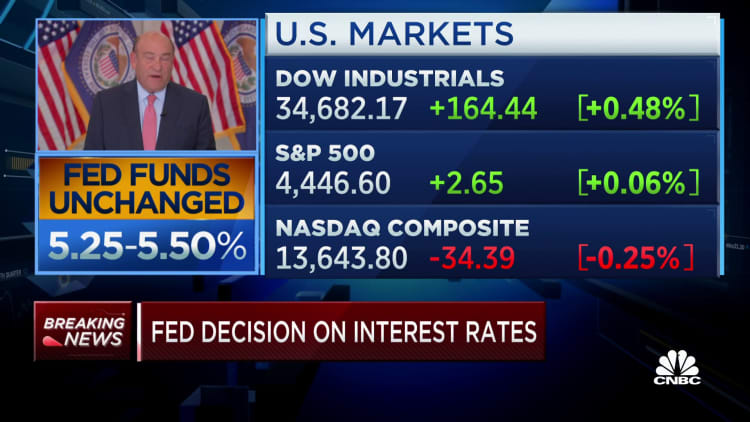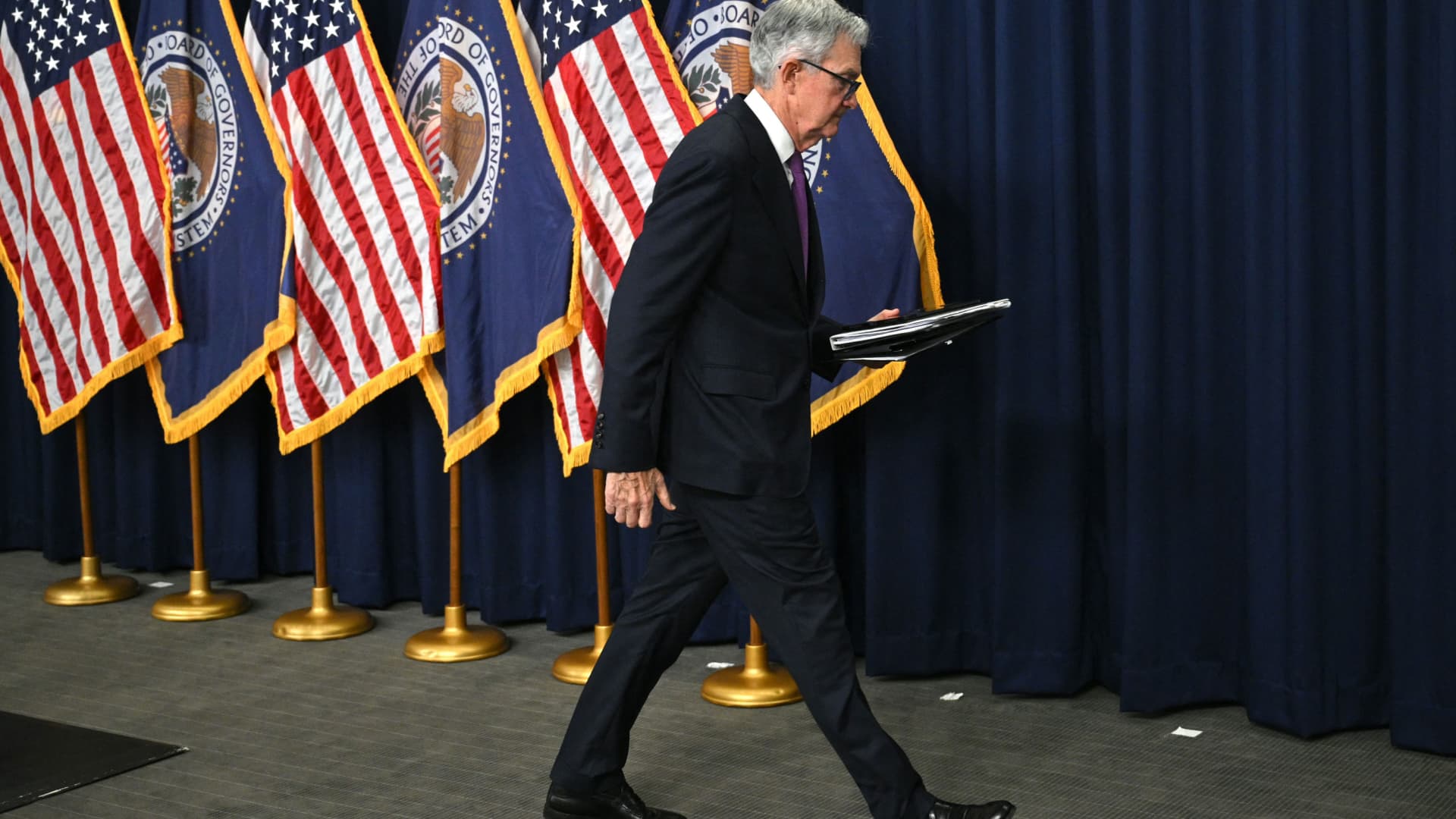
The Federal Reserve held interest rates steady in a decision released Wednesday, while also indicating it still expects one more hike before the end of the year and fewer cuts than previously indicated next year.
That final increase, if realized, would mark the end of this cycle, according to projections released by the central bank at the end of its two-day meeting. If the Fed follows through with the move, it would make a total of twelve hikes since the policy tightening began in March 2022.
Market expectations aligned with no rate hike at this meeting, resulting in the fed funds rate remaining in the targeted range of 5.25%-5.5%, the highest in approximately 22 years. This rate impacts overnight lending rates between banks and also affects various forms of consumer debt.
Although the lack of a rate hike was anticipated, there was considerable uncertainty regarding the future actions of the rate-setting Federal Open Market Committee (FOMC). Documents released on Wednesday suggest a bias towards a more restrictive policy and a prolonged period of higher interest rates.
This outlook had a negative impact on the market, with the S&P 500 falling by nearly 1% and the Nasdaq Composite dropping by 1.5%. Stock prices fluctuated during Fed Chair Jerome Powell’s news conference.
Powell stated, “We’re in a position to proceed carefully in determining the extent of additional policy firming.”
However, he also highlighted the central bank’s desire to see further progress in their fight against inflation, saying, “We want to see convincing evidence that we have reached the appropriate level, and we’re seeing progress and we welcome that. But, you know, we need to see more progress before we’ll be willing to reach that conclusion.”
The Fed’s dot plot projections indicate a likelihood of one more rate increase this year, followed by two cuts in 2024, two fewer than previously indicated in the June update. This would bring the funds rate to approximately 5.1%. The dot plot allows FOMC members to anonymously indicate their rate forecasts.
At the meeting, twelve participants penciled in the additional hike, while seven opposed it. This marks one more member in opposition compared to the June meeting. The projection for the fed funds rate in 2025 also increased, with the median outlook at 3.9%, compared to the previous forecast of 3.4%.
Looking further ahead, FOMC members expect a funds rate of 2.9% in 2026. This is above the Fed’s considered “neutral” interest rate, which neither stimulates nor restricts economic growth. It is the first time the committee has provided a glimpse into 2026. The long-run expected neutral rate remains at 2.5%.
Citigroup economist Andrew Hollenhorst wrote, “Chair Powell and the Fed sent an unambiguously hawkish higher-for-longer message at today’s FOMC meeting. The Fed is projecting inflation to steadily cool, while the labor market remains historically tight. But, in our view, a sustained imbalance in the labor market is more likely to keep inflation ‘stuck’ above target.”
Economic growth seen higher
In addition to rate projections, FOMC members substantially revised their economic growth expectations, with gross domestic product (GDP) now expected to increase by 2.1% this year. This is more than double the June estimate and suggests that members do not foresee a recession in the near future. The outlook for GDP in 2024 also improved, rising to 1.5% from 1.1%.
The expected inflation rate, as measured by the core personal consumption expenditures price index, decreased to 3.7%, down 0.2 percentage points from June. The unemployment outlook also improved, with a projected rate of 3.8%, compared to the previous forecast of 4.1%.
The post-meeting statement underwent a few changes to reflect the adjustment in the economic outlook. The committee now describes economic activity as “expanding at a solid pace,” replacing the previous term “moderate.” It also noted that job gains have slowed but remain strong, in contrast to earlier language describing the employment picture as “robust.”
In addition to keeping rates relatively high, the Fed is continuing to reduce its bond holdings, resulting in a reduction of the central bank’s balance sheet by approximately $815 billion since June 2022. The Fed is allowing up to $95 billion in proceeds from maturing bonds to roll off each month, rather than reinvesting them.
A shift to a more balanced view
The Fed’s actions come at a critical juncture for the U.S. economy.
In recent public appearances, Fed officials have indicated a shift in their thinking, moving from the belief that it was better to take aggressive action against inflation to a more balanced approach. This change is partly due to the perceived delayed effects of the previous rate hikes, which represented the most stringent monetary policy from the Fed since the early 1980s.
There are signs that the central bank may achieve its goal of containing inflation without causing a severe recession. However, uncertainty remains, and Fed officials are cautious about declaring victory prematurely.
“We, like many, expected to see the hawkish stance that Powell mentioned at Jackson Hole,” said Alexandra Wilson-Elizondo, deputy chief investment officer of multi-asset strategies at Goldman Sachs Asset Management. “However, the release was more hawkish than expected. While some past policy tightening is still in the pipeline, the Fed can adopt a wait-and-see approach. However, the main risk lies in damaging their largest asset, anti-inflation credibility, which calls for a favorable reaction towards hawkishness.”
Wilson-Elizondo pointed out that the recent rise in energy prices and resilient consumer spending are likely reasons for the upward revision of next year’s median dot.
“We don’t foresee a single bearish catalyst in the near future, although strikes, the shutdown, and the resumption of student loan repayments will collectively cause bumps in the data until the next decision. Consequently, we believe that their next meeting will be significant but not definitive,” Wilson-Elizondo said.
The job market has remained strong, with an unemployment rate of 3.8%, only slightly higher than a year ago. Job openings have declined, indicating progress in resolving the supply-demand imbalance that once saw two job opportunities for every available worker.
Inflation data has also improved, although the annual rate remains significantly above the Fed’s 2% target. The Fed’s preferred inflation gauge in July indicated core inflation, excluding volatile food and energy prices, at a rate of 4.2%.
Consumers, who contribute two-thirds of economic activity, have displayed resilience, continuing to spend despite lower savings and credit card debt surpassing $1 trillion for the first time. The University of Michigan’s survey reported multi-year lows in inflation rate expectations for both the one- and five-year outlooks.
Correction: The Federal funds target rate is within the range of 5.25-5.5%. A previous version of this story misstated the range’s end point.
Denial of responsibility! Vigour Times is an automatic aggregator of Global media. In each content, the hyperlink to the primary source is specified. All trademarks belong to their rightful owners, and all materials to their authors. For any complaint, please reach us at – [email protected]. We will take necessary action within 24 hours.


